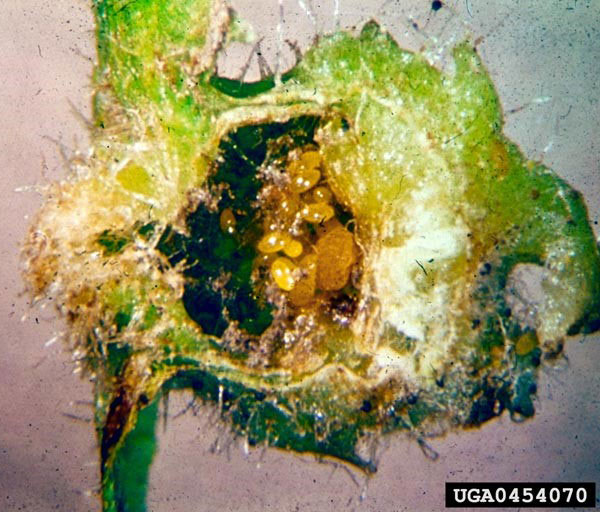Background
Grape phylloxera is a small, aphid-like insect that infests grape plants. It has been placed into the species "Daktulosphaira vitifoliae", although it has also been recorded under the name "Viteus vitifoliae". Native to eastern North America, it does little harm to native species of wild grape. On Vitis vinifera, the species of grape used for commercial wine and grape production in Europe, it does great harm, and it nearly destroyed the grape and wine industries in Europe when accidently introduced there in the 1800s. The only solution found was to graft favoured grape varieties onto North American rootstocks, and now nearly all grapes planted are grafted onto resistant rootstock. This has been so effective that research into other treatments has all but been abandoned. Ungrafted vines are commonly used in production areas that do not have phylloxera and the extra production costs are then avoided.
Distribution
Grape phylloxera is essentially found in every country that grows grapes. Native to eastern North America, it was brought around the world in the 1800s with new cultivars and has continued to spread ever since. In Canada, grape phylloxera occurs naturally in Ontario through Nova Scotia. It has also been detected at low levels in the Okanagan Valley over the last 60 years.
Hosts
Grape phylloxera form galls (swellings on plant surfaces) on the leaves and / or roots of grapevines. The occurrence and location of these galls depends on the strain of phylloxera, the species and variety of grapevine (graft and rootstock), the soil, and other conditions.
Biology
The life cycle of phylloxera is complicated and goes through many stages and several specialised forms, including: larvae, asexual and sexual forms and winged and wingless forms. They can be leaf-galling or root-galling and several generations can be produced each season.
The root-galling forms cause far more commercial damage than the leaf-galling ones. The leaf-galling form has only been found to damage grape varieties with North American heritage, such as those grown for rootstocks and some commercial grape varieties.
Asexual, wingless females live in the galls and can each produce up to 200 eggs. These eggs can hatch into larvae or "crawlers" who can migrate to new places or be blown by the wind and form new galls. Occasionally a winged form of phylloxera emerges from root-inhabiting forms and can fly to new sites. These winged females can produce sexual male and female phylloxera. After mating, the female will lay a single larger egg which will survive for the winter. Crowding on the roots or high soil moisture can stimulate the production of winged forms. They are not strong fliers and also do not feed. When they land on grape stems they lay their few eggs and die. Apart from the overwintering forms, the life span of the phylloxera is very short, and several generations can be produced in a year.
Identification
Phylloxera are very small (0.5 to 1mm long) bright orange, yellow, green or brown (depending on life stage and feeding site) aphid-like insects that are usually not directly seen. The leaf galls they make are evident as round swellings on the undersides of the leaves. Leaf galls can be cut open to see the phylloxera inside. Root galls can be seen at the tips of the roots and along the roots themselves and are identifiable as swellings a few millimetres in length. The phylloxera live inside the galls, except for newly-hatched, nearly microscopic "crawlers" and winged forms that may be seen on the plant.
Detection and Damage
Phylloxera are usually detected because of vine or leaf damage rather than by seeing the actual insect. This means that once the harm is seen, they have been present for a while and are probably well established in the vineyard. Vines yellow and weaken, usually (but not always) in a patch that slowly expands, often to windward. Heavily infested leaves are deformed and may fall prematurely.
Where root galls are a problem, the damage usually starts as changes in leaf colour (which can be used in remote sensing to find populations of the phylloxera) and decreased cane growth, followed by leaf death especially during summer heat stress periods. Over time, the roots simply die back to the point where they can't support the plant, and the plant dies. Death of vines in a vineyard usually occurs locally, with a pattern of spread which is oriented with the prevailing winds, suggesting the crawlers can be carried by the wind. Vine death is most rapid on clay soils with moderate temperatures, and slower in very cool or very hot places, especially on sandy soil. Because the phylloxera spreads faster than their visible harm, once the harm is noticeable, the insect itself is firmly established and moving through the vineyard.
While the exact mechanism for plant death is unknown, it is thought to be caused by fungal infection into the damaged plant tissue, rather than the feeding of the insects themselves, especially in the root system. Leaf damage is thought to be due to reduced photosynthesis. Sometimes the plant simply drops leaves that have become too infested.
Click on images for larger view
-

Figure 1 – Typical phylloxera-induced leaf galls on the underside of a grape leaf -

Figure 2 – Typical phylloxera-induced leaf galls on the underside of a grape leaf -

Figure 3 – Grapevine showing stunted growth due to phylloxera -

Figure 4 – Cross section of grapevine leaf gall caused by phylloxera -

Figure 5 – Root galls on grapevine roots